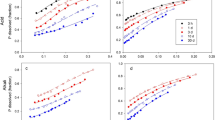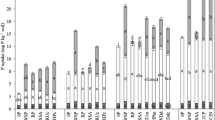Abstract
The fertilizer reaction products formed during the dissolution of PAPR fertilizer applied to two soils of contrasting P retention were studied using electron microscopy and energy dispersive x-ray spectrum (EDS) analysis combined with common mineralogical analysis procedures. Monocalcium phosphate (MCP) and phosphate rock (PR) residue were the main components of the PAPR fertilizer at the time of application. Dissolution of MCP in PAPR led to the formation of dicalcium phosphate dihydrate (DCPD) which was morphologically distinct from the soil matrix and easily analyzed by the microprobe. The amount of DCPD at the granule site was greater in the soil of low P retention than in the soil of high P retention, consistent with a greater transfer of fertilizer-P to the soil in latter case. The mean crystallite size of carbonate apatite in the fertilizer residue suggested a preferential dissolution of very fine crystallites at acidulations less than 50% during phosphoric acid acidulation. Electron microscopy showed dissolution of primary mineral grains (e.g. clinopyroxene) in soil adjacent to the fertilizer pellet during the dissolution of PAPR fertilizer. The precipitated products in the soil near the PAPR fertilizer pellet were complex compounds containing P, Ca, Al, Fe and Si. There was no evidence of pure phases such as variscite and strengite. These changes were analogous to those occurring in and around fully acidulated P fertilizers (TSP) in soil; however, in the case of PAPR, the reactive phosphate rock residue and DCPD at the site of application may provide a continuous source of P for plants over a long period.
Similar content being viewed by others
References
Asher CJ and Loneragan JF (1967) Response of plants to phosphate concentration in solution culture: 1. Growth and phosphorus content. Soil Sci 103: 225–233
Benbi DK and Gilkes RJ (1987) The movement into soil of P from superphosphate grains and its availability to plants. Fert Res 12: 21–36
Brown LE and Lehr JR (1959) Application of phase rule to the behavior of monocalcium phosphate monohydrate in soils. Soil Sci Soc Am Proc 23: 7–11
Charlston AG Condron LM and Brown WM (1989) The nature of residual apatites remaining after partial acidulation of phosphate rocks with phosphoric acid and sulfuric acids. Fert Res 18: 257–273
Davey BG and Shayan A (1980) Reaction between monocalcium phosphate monohydrate and a Chromic Luvisol: I. The morphology of reaction products. Soil Sci Soc Am J 44: 474–477
Golden DC, White RE, Tillman RW and Stewart RB (1991) Partially acidulated reactive phosphate rock (PAPR) fertilizer and its reactions in soil: I. Initial movement of dissolved ions and solubility of the phosphate rock residue. Fert Res 28: 281–293
Hagin J and Katz S (1985) Effectiveness of partially acidulated phosphate as a source to plants in calcareous soils. Fert Res 8: 117–127
Klug HP and Alexander LE (1974) X-ray diffraction procedures for polycrystalline and amorphous materials. 2nd Ed., John Wiley & Sons, New York, pp 966
Lehr JR, Brown WE and Brown EH (1959) Chemical behavior of monocalcium phosphate monohydrate in soils. Soil Sci Soc Am Proc 23: 3–7
Lindsay WL and Stephenson HF (1959a) Nature of reactions of monocalcium phosphate monohydrate in soils: I. The solution that reacts with the soil. Soil Sci Soc Am Proc 23: 12–18
Lindsay WL and Stephenson HF (1959b) Nature of the reaction of monocalcium phosphate monohydrate in soils. II. Dissolution and precipitating reactions involving iron, aluminum, manganese and calcium. Soil Sci Soc Am Proc 23: 18–22
Lindsay WL and Stephenson HF (1959c) Nature of the reaction of monocalcium phosphate monohydrate in soils: Repeated reactions with metastable triple point solution. Soil Sci Soc Am Proc 23: 440–445
Sanchez PA (1976) Properties and management of soils in the tropics. John Wiley, New York, pp 263
Scotter DR and Raats PAC (1969) Movement of salt and water near crystalline salt in relatively dry soil. Soil Sci 109: 170–178
Stephen RC and Condron LM (1986) An assesment of the agronomic efficiency of partially acidulated phosphate rock fertilizers. Fert Res 10: 269–282
Van Wazer JR (1964) Phosphorus and its compounds. Vol I: Chemistry. Interscience Publ, pp 954
Author information
Authors and Affiliations
Rights and permissions
About this article
Cite this article
Golden, D.C., Stewart, R.B., Tillman, R.W. et al. Partially acidulated reactive phosphate rock (PAPR) fertilizer and its reactions in soil. Fertilizer Research 28, 295–304 (1991). https://doi.org/10.1007/BF01054330
Received:
Accepted:
Issue Date:
DOI: https://doi.org/10.1007/BF01054330




